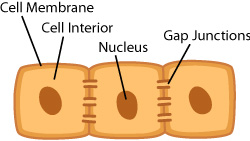Q1: What is the purpose of the pericardium?
The pericardium is a double sac of serous membrane that secretes a fluid to lubricate the heart and reduce friction. It also protects the heart.
Q2: Observe the blood vessels connecting to the heart. How do arteries differ from veins in their structure?
Veins have thinner walls than arteries and are also one way valves (prevent back flow of blood). Arteries carry blood away from the heart to the tissue while veins carry blood to the heart from the tissue. Veins store the most blood volume in the body. Arteries are elastic and contractile.
Q3: Place your finger inside the auricle. What function do you think the auricle serves?
The auricle feels rough when we placed our finger inside the auricle. Auricle increases blood capacity and volume in the atrium and also collect blood.
Q4: Observe the external structures of the atria and ventricles. What differences do you observe?
The right atria is the upper chamber that receives oxygen deprived blood. The right ventricle a lower chamber that discharges blood. The left atria is the upper chamber that receives oxygen rich blood. The left ventricle is a lower chamber that has the thickest wall. In structure, the ventricle has thicker walls and takes up more space.
Q5: Find and Describe the following structures in the heart:
1. Coronary Sinus: a wide venous channel that receives blood from the coronary veins and empires into the right atrium of the heart.
2. Inferior Vena Cava: (carries blood from lower body) a large vein and empties into the right atrium of the heart. The superior vena cava carries blood from upper body.
3. Tricuspid Valve: Located between the right atrium and right ventricle; it prevents back flow of blood into the atrium
Q5: Find and Describe the following structures in the heart:
1. Coronary Sinus: a wide venous channel that receives blood from the coronary veins and empires into the right atrium of the heart.
2. Inferior Vena Cava: (carries blood from lower body) a large vein and empties into the right atrium of the heart. The superior vena cava carries blood from upper body.
3. Tricuspid Valve: Located between the right atrium and right ventricle; it prevents back flow of blood into the atrium
Q6: Draw a picture of the tricuspid valve, including chordate tendinae and the papillary muscle.
Picture:
Q7: Why is the “anchoring” of the heart valves by the chordate tendinae and the papillary muscle important to heart function?
After the right ventricle contracts, the blood pressure pushes on the tricuspid valve, which stops the blood flow to the right atria. The job of chordae tendinae is to make sure the side edges of the valve don’t get pushed into the atria. It is important because it stops the valve from pushing blood in the wrong direction.
Q8: Using pictures and/or words describe what you see (bicuspid valve)
Picture:
The probe in this picture points to the bicuspid valve, which is between the left atrium and ventricle
Q9: What is the function of the semi-lunar valves?
The Semilunar valves prevent arterial blood from re-entering the heart. Two types are the pulmonary semilunar valve and the aortic semilunar valve.
Q10: Valvular heart disease is when one of more heart valves does not work properly. Improperly functioning heart valves can lead to regurgitation, which is the backflow of blood through a leaky valve. Ultimately this can lead to congestive heart failure, a condition that can be life threatening.
If the valve disease occurs on the right side of the heart, it results in swelling in the feet and ankles. Why might this happen?
The ventricles are not strong enough to pump blood against gravity from your toes and feet. Blood is not able to function normally and back flow occurs.
If the valve disease occurs on the left side of the heart, what complications would you expect to see?
If the valve disease occurs on the left side of the heart, not enough blood would be pumped. Therefore, swelling would occur.
Q11: Using pictures and/or words describe what you see (left/right coronary arteries, left semilunar valve (3 cusps), chord tendinae of bicuspid valve, and pillar muscle of the bicuspid valve)
a. Entrance to the left/right coronary arteries: The coronary arteries supply blood to the heart.
b. Left (aortic) semilunar valve (3 cusps): The aortic semilunar valves prevent arterial blood from re-entering the blood.
c. Chordae Tendinae of the Bicuspid Valve: Chordae Tendinae are tendons attached to cusps of valves.
d. Papillary Muscle of the Bicuspid Valve: They provide "muscle power" and they pull on the chordae tendinae to open/close valve.
b. Left (aortic) semilunar valve (3 cusps): The aortic semilunar valves prevent arterial blood from re-entering the blood.
c. Chordae Tendinae of the Bicuspid Valve: Chordae Tendinae are tendons attached to cusps of valves.
d. Papillary Muscle of the Bicuspid Valve: They provide "muscle power" and they pull on the chordae tendinae to open/close valve.
Q12: Describe how the left and right sides of the heart differ from each other.
The right side of the heart pumps deoxygenated blood to the lungs. The left side of the heart pumps oxygenated blood to the aorta and out to the rest of the body. Also, the right side of the heart has thinner walls while the left side of the heart has thicker walls.
Q13: Draw and label all structures visible in the interior of the cross-section.




















